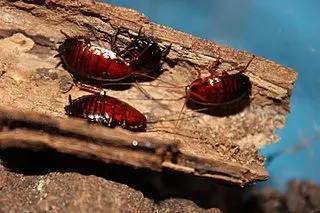Florida Woods Cockroach

Cockroaches – Most people associate them with infestations and uncleanliness, but not all species of cockroaches are pests. Some play essential roles in various ecosystems.
One such species is the Florida Woods Cockroach. Often mistaken for other species and recognized for its unique defense mechanism, it is a creature worth understanding.
Quick Facts
| Feature | Description |
|---|---|
| Size | 1.5 inches long, 1 inch wide |
| Color | Reddish-brown to black |
| Diet | Decaying plants, mold, moss |
| Habitat | Damp, dark places; wooded areas |
| Lifespan | Over a year |
| Reproduction | Eggs produced with/without fertilization |
| Geographical Range | Coastal Alabama, Georgia, Florida, Mississippi, West Indies |
Appearance
- Size: Measuring about an inch and a half long and up to one inch wide, the Florida Woods Cockroach isn’t tiny. Its size can often lead to discomfort when encountered, especially for those unfamiliar with it.
- Color: This cockroach boasts a reddish-brown to black hue. The dark color allows it to camouflage effectively in its natural wooded environment.
- Characteristics: Unlike many cockroach species, the Florida Woods Cockroach does not have fully developed wings. At a glance, it might appear wingless. However, upon closer inspection, one can discern the short vestigial wings, hinting at its evolutionary journey.
Behavior
Given its frequent hiding spot, this roach is sometimes endearingly called the “palmetto bug.” This name can be misleading, as many species get lumped under the ‘palmetto bug’ moniker, including other types of cockroaches and even some beetles.
If you’ve ever heard of a ‘stinking cockroach,’ this is the one. When threatened, the Florida Woods Cockroach releases a distinct odor from a gland under its abdomen. This is not just for show – it’s a vital defense mechanism. This roach isn’t winning any races, and its slow-moving nature makes this chemical defense crucial for its survival.

Diet
Like most cockroaches, the Florida Woods Cockroach isn’t picky. Primarily, they consume decaying plants, mold, and moss. This might sound unappetizing, but it plays an integral role in nutrient cycling in the environment, breaking down organic materials.
Habitat
- Lifestyle: If you’re picturing a damp, dark environment abundant in food, you’ve nailed the preferred living space of the Florida Woods Cockroach. Naturally, wooded areas are ideal.
- Common Spots: Indoors, they gravitate towards bathrooms and basements where dampness persists. Outdoors, you might find them among leaf litter, nestled under palmetto leaves, or hanging around leaking pipes. Trees and woodpiles also provide shelter and food, making them popular choices.
Geographical Range
Warmth and humidity are friends of the Florida Woods Cockroach. Thus, it’s common to find them in Alabama, Georgia, and Mississippi coastal regions. Florida, as the name suggests, is a hotspot. Beyond the U.S., they’ve also made their mark in the West Indies.
Life Cycle
The reproductive cycle of the Florida Woods Cockroach is particularly intriguing. Females can produce eggs both with and without fertilization. They lay ootheca, or egg cases, which give rise to nymphs in about 50 days.
Undergoing six to eight molts, these nymphs mature into adults over several months. The entire lifespan of these cockroaches can extend beyond a year.
Conclusion
Understanding the Florida Woods Cockroach challenges us to look beyond our preconceived notions about cockroaches. Like all creatures, it plays a unique role in its ecosystem and has evolved distinct strategies to survive and thrive.
Whether you’re a budding entomologist or a curious reader, there’s no denying the fascinating world of this often-misunderstood insect.

James E. Butkovich, Pest control maven with a knack for eco-friendly & Chemical solutions. Blogger with a mission to make homes pest-free, one post at a time.